Solidigm P41 Plus 2TB SSD Review - DRAMless Perfection
DRAMless and QLC is about as cost-effective as it gets, but man, the performance will be awful right? Right? Solidigm's P41 Plus 2TB SSD proves otherwise.
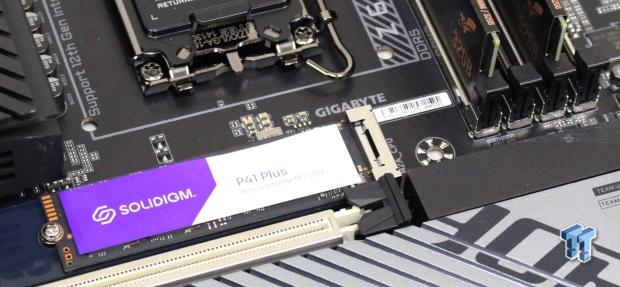

The Bottom Line
Pros
- + Gaming
- + Consumer workloads
- + Pricing
Cons
- - None
Should you buy it?
AvoidConsiderShortlistBuyIntroduction & Drive Details
As you may or may not know, Intel sold off its flash business to the South Korean memory giant SK hynix. We believe that the primary reason for SK hynix' purchase of Intel's NAND business, which also encompasses its SSD business, boils down to a three-letter acronym, QLC or Quad-Level Cell or 4-bit flash. Why would the world's second-largest producer of NAND flash memory be willing to fork over billions of dollars to acquire a competitor's flash business, especially considering it apparently wasn't profitable enough for Intel to continue with? SK hynix makes flash. Why not just make their own QLC?
We believe, and this is nothing but pure speculation on our part, that Intel's QLC flash technology is so good, so much better than anything anyone else has, including SK hynix, that the South Korean memory giant saw an opportunity in Intel they could not pass on. We've seen it for years now, really beginning with Intel's 128 Layer QLC and now with its 144 Layer QLC. This stuff is awesome, and it is, in fact, able to deliver better performance than some competing TLC flash. Now we understand that doesn't sound possible, but we will demonstrate this reality right here today.
So, what is SK Hynix going to do with Intel QLC flash? Well, apparently, just change the name to Solidigm is what they are going to do, and as the parent company, they are going to reap the rewards that QLC's density brings to the table. Intel SSDs are now Solidigm SSDs, and as far we can discern, SK hynix isn't changing a thing, not even the employees, as all the familiar formerly Intel SSD crew are now the Solidigm SSD crew. After all, why change a great thing? The world's best-of-its-kind 4-bit flash didn't get that way by accident.
So on to the SSD we have on the bench today. Solidigm's first Client SSD, the P41 Plus. Now if that name sounds familiar it's because it is play on the naming convention of SK hynix's first PCIe Gen4 consumer SSD, the Platinum P41. See, what they did there was tie Solidigm back to SK hynix with a similar naming convention. However, that's the only thing that ties Solidigm's first client SSD back to its South Korean parent company.
The P41 Plus is pure Intel, errr... Solidigm. Solidigm's primary role, as we see it, is what we would describe as the "Density Arm" of SK hynix. The P41 Plus is typical of what we were seeing from past Intel consumer SSDs in that it's sporting a Silicon Motion controller in front of an Intel QLC flash array only now with more modern components interfacing over PCIe Gen4 x4.
The P41 Plus, if memory serves us correctly, is the first DRAMless flash-only (no Optane) QLC SSD we've encountered. Solidigm classifies its P41 Plus as a client drive, meaning it is sold primarily to OEM clients. However, we found the P41 Plus can be had through retail channels as well as it's currently for sale at Amazon. Well, let's see what this seemingly modest SSD has to offer in terms of performance that matters, or as we call it -User Experience.
Drive Details
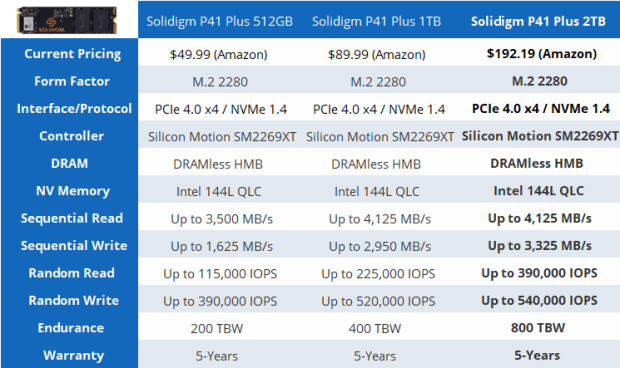
The P41 Plus can currently be had for less than 10 cents per gigabyte. Very nice pricing, especially right out of the gate. The drive currently is as cheap or cheaper than the ATOM 50, the FX900, P400, and the SN770, all of which are Gen4 DRAMless competitors. The aforementioned competitor DRAMless offerings are all arrayed with TLC flash, seemingly giving them an insurmountable performance advantage over the P41 Plus. However, as we see it, this SSD presents us with the perfect opportunity to demonstrate our seemingly crazy assertion that Intel QLC is, in fact, superior in terms of real performance to much of the TLC flash currently in circulation. We've proven this before with Intel's 670p 144L QLC SSD but it wasn't DRAMless. Time to do it again, this time with a DRAMless SSD.
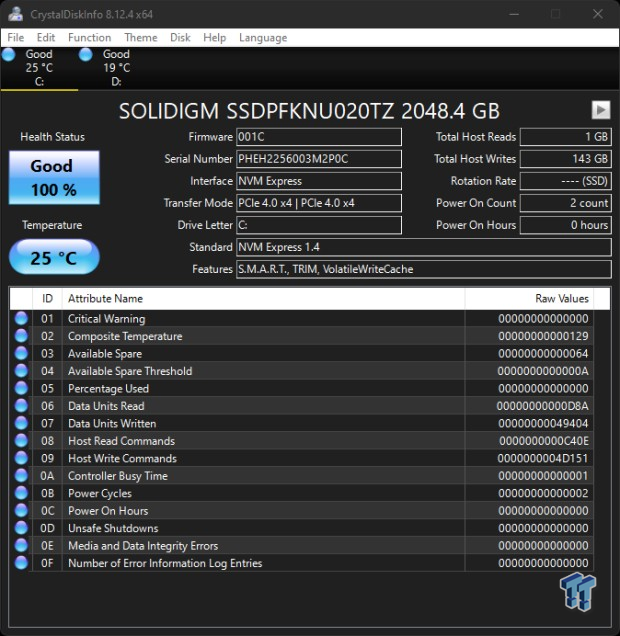
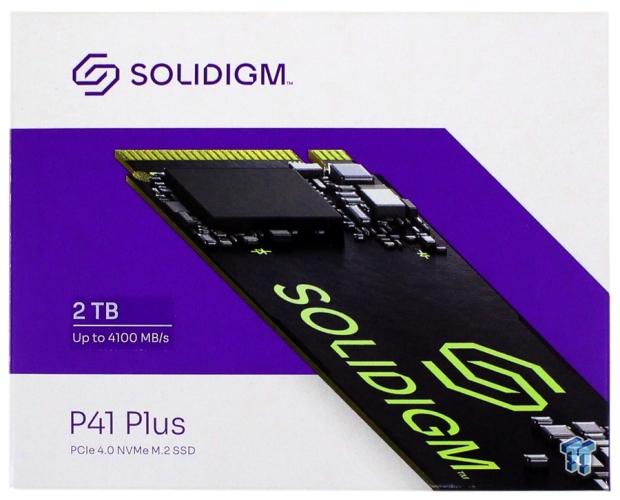
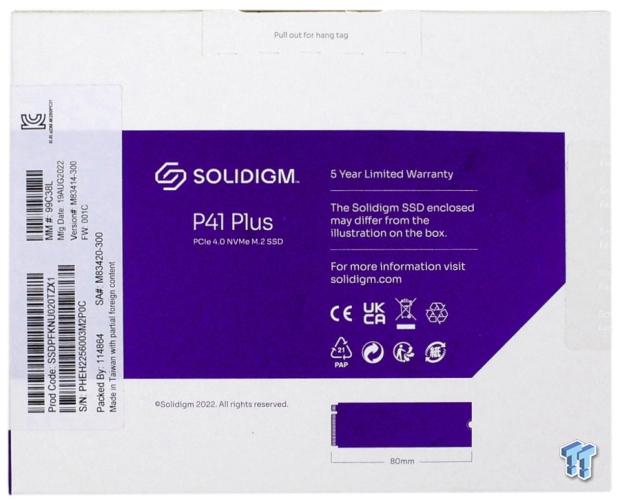


The P41 Plus represents our first experience with Silicon Motion's SM2269XT 4-channel PCIe Gen 4 x4 DRAMless controller. If the SM2269XT follows SMI tradition, it should offer class-leading performance. We shall see.
Jon's Test System Specifications
- Motherboard: ASUS ROG Z690 HERO
- CPU: Intel Core i9-12700K - Buy from Amazon
- Cooler: Alphacool Eissturm Hurricane Copper 45 - Buy from Amazon
- RAM: Sabrent Rocket DDR5 32GB - Buy from Amazon
- Graphics Card: MSI SUPRIM X RTX 3080 12GB - Buy from Amazon
- Case: PrimoChill's Praxis Wetbench - Buy from Amazon
- Power Supply: be quiet! Dark Power Pro 12 1200W - Buy from Amazon
- OS: Microsoft Windows 11 Pro 64-bit - Buy from Amazon

Synthetic Benchmarks: CDM, Anvil, ATTO
CrystalDiskMark
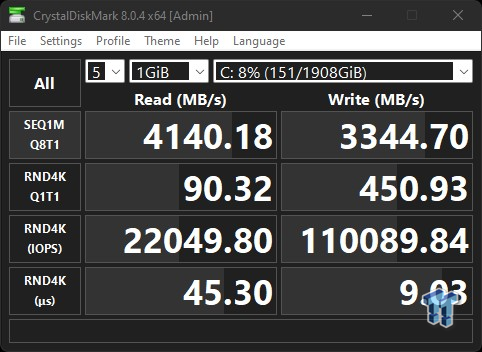
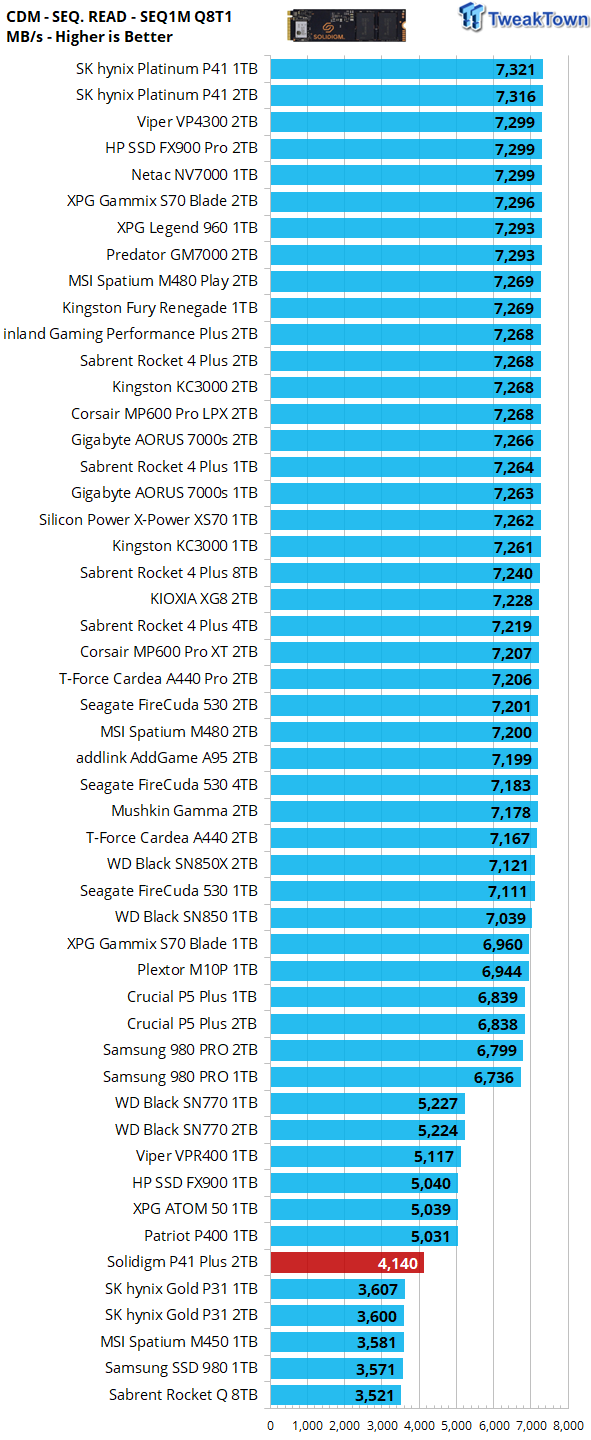
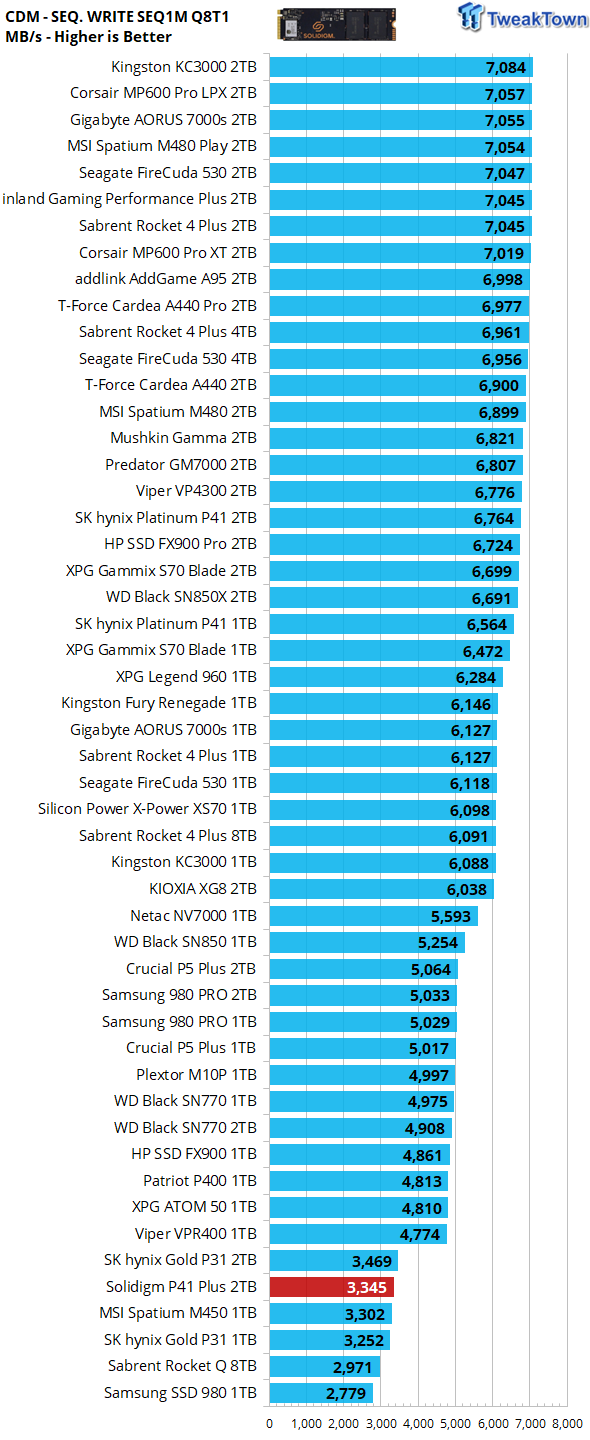
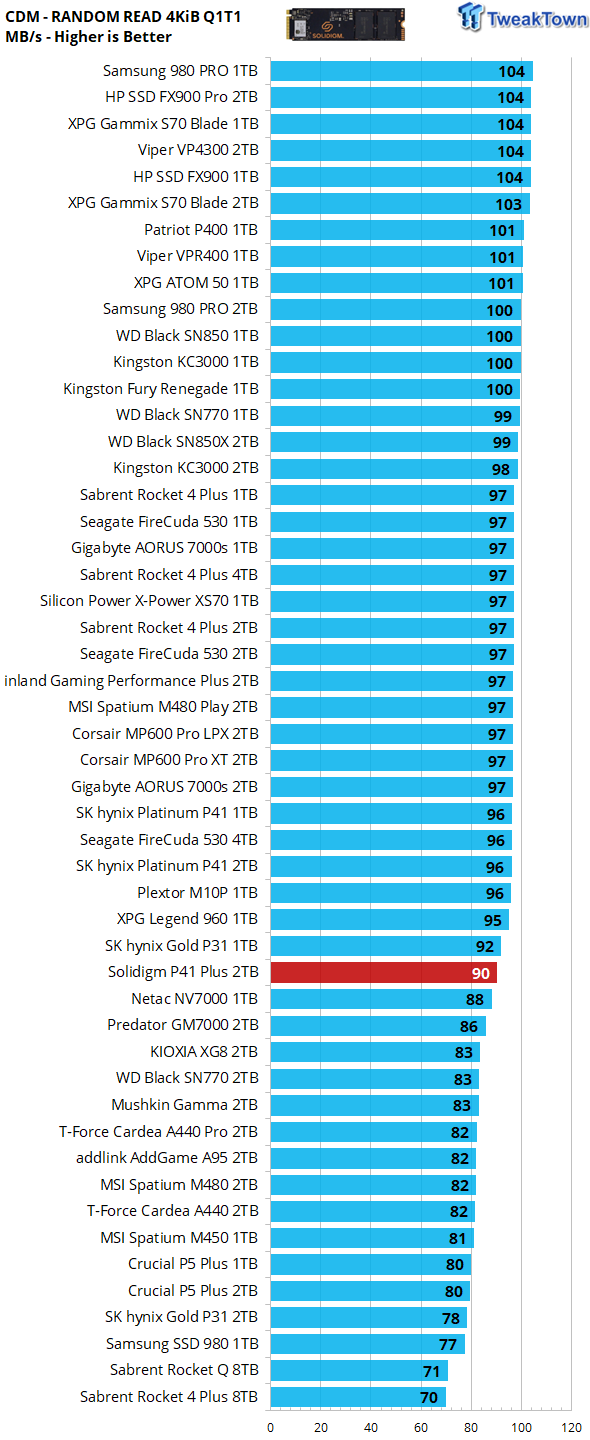
Throughput numbers are certainly nothing to write home about, which is as expected for a QLC SSD, especially a DRAMless one. However, the good news here is sequential throughput has very little to do with how well an SSD performs in the real world.
The number to keep an eye on is that 90.32 MB/s Q1T1 random read as it is very good, at least it is well within the range of what we will typically see coming from a superior performing SSD. Certainly, the best we've ever seen from any consumer QLC SSD.
Anvil's Storage Utilities
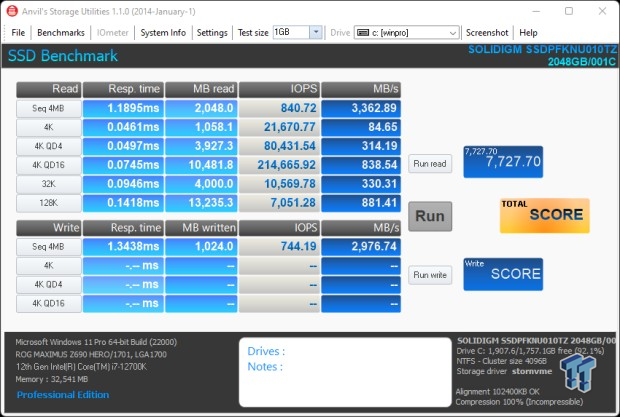
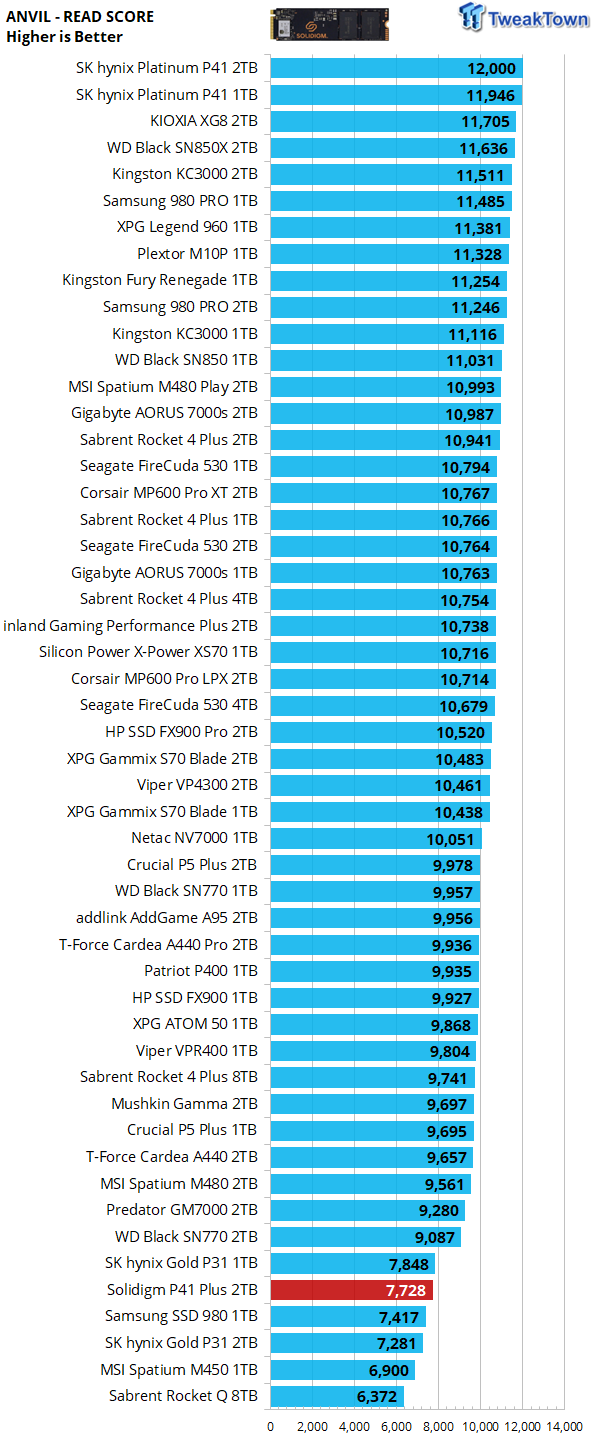
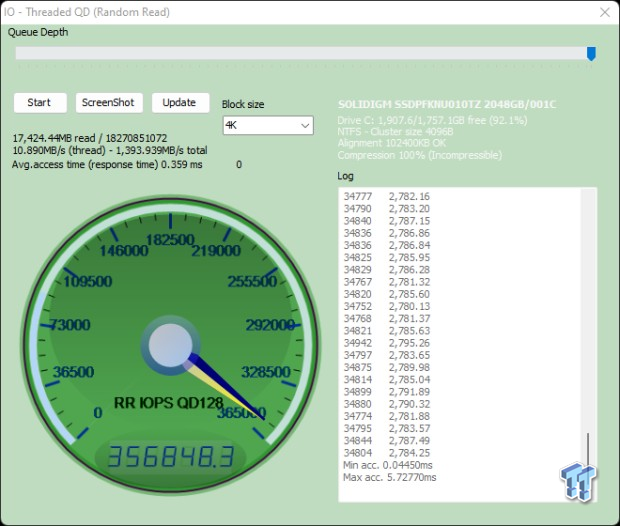
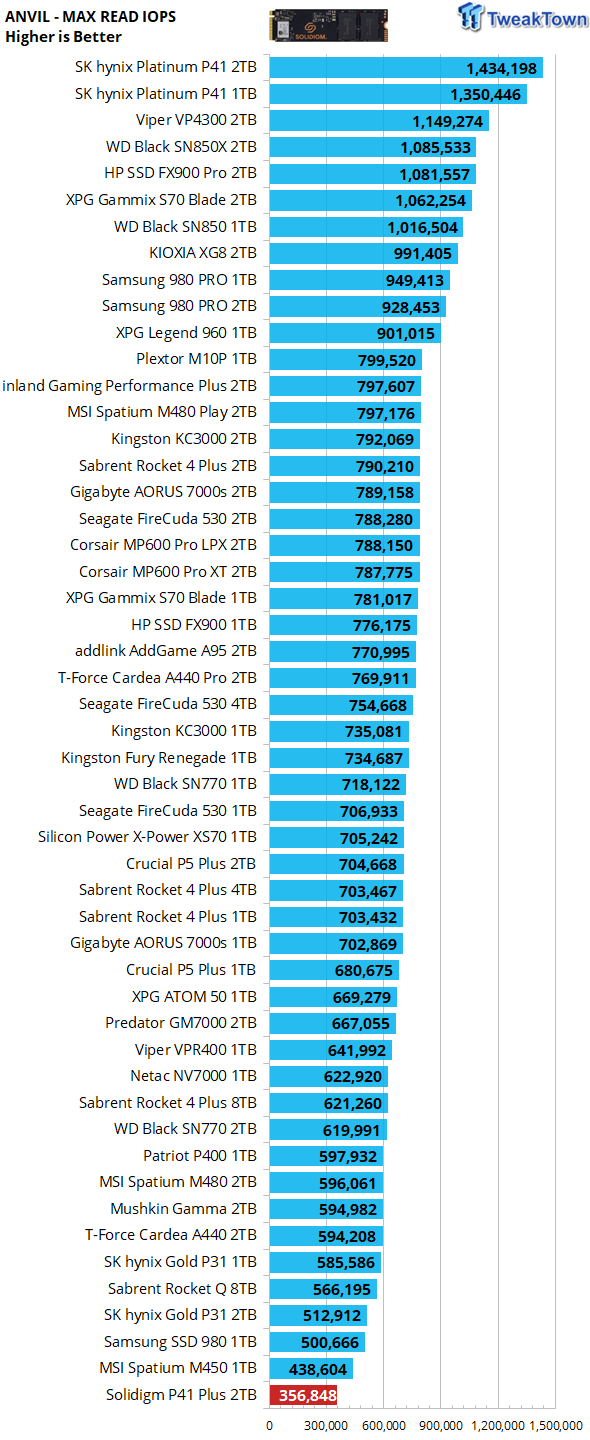
Like its predecessor, the 670p, the P41 Plus isn't going to give many synthetic indications of its true performance capabilities other than its low queue depth random read numbers. Here its 4K and 4K QD4 random read performance is very good, and those particular numbers point to potentially excellent real-world performance, gaming included.
ATTO
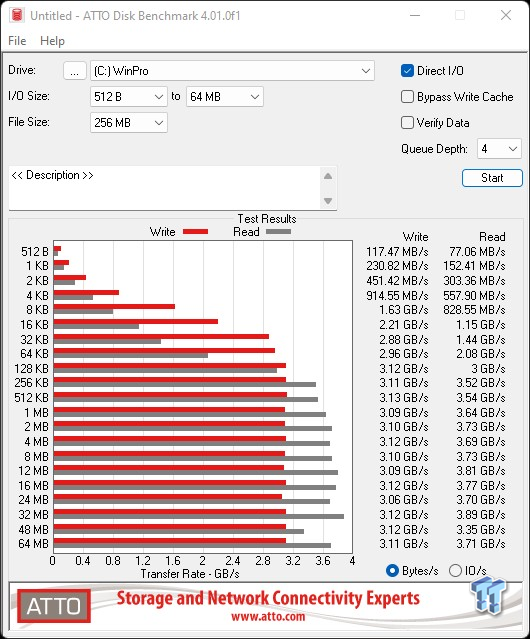
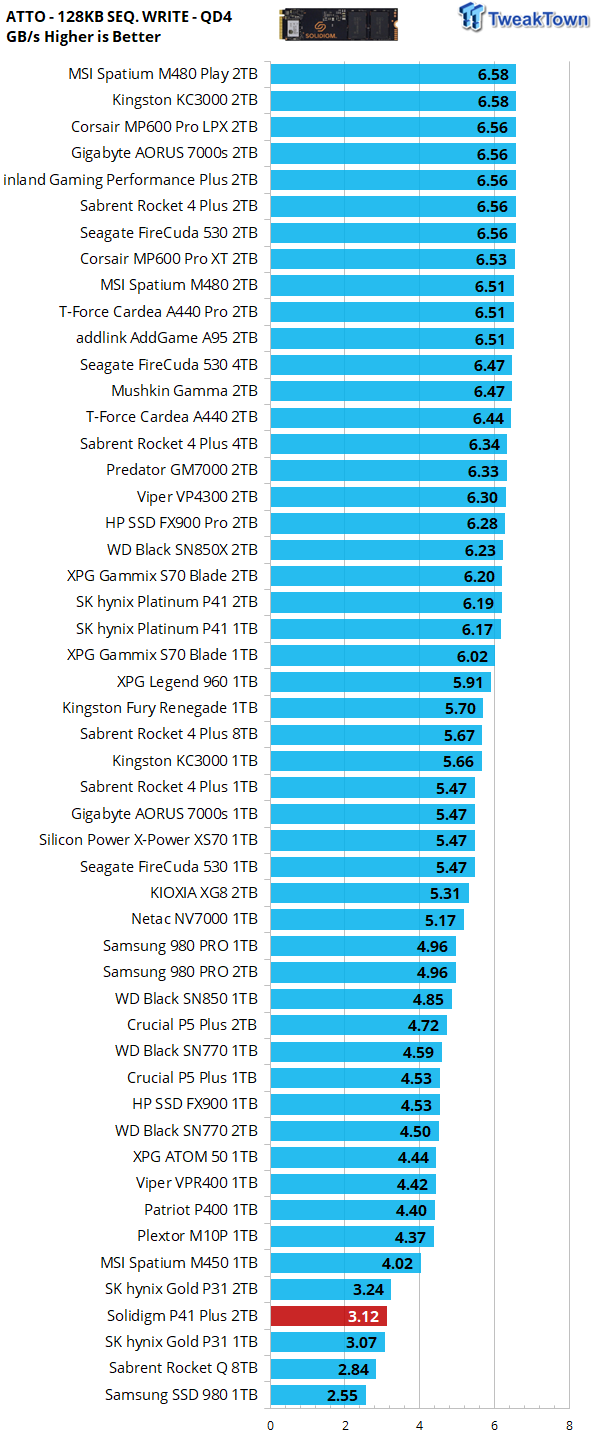
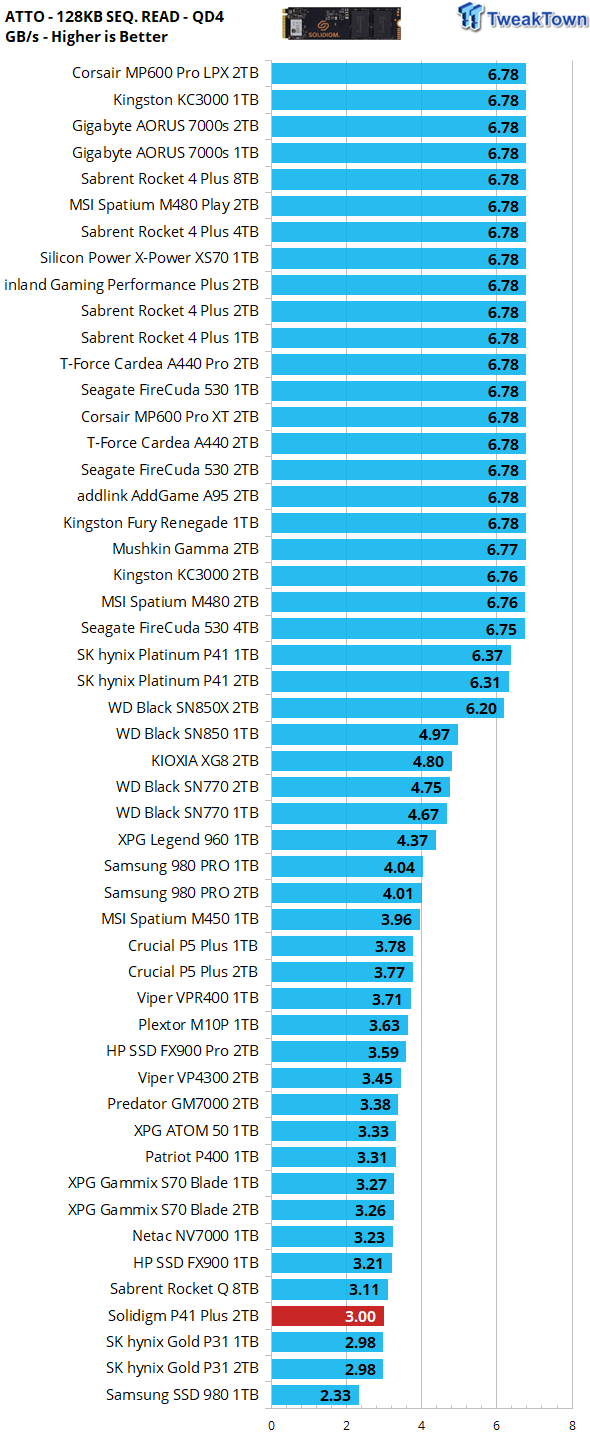
Sequential performance at QD4 is, as expected, underwhelming, to say the least. Do keep in mind that sequential speeds, contrary to popular belief, have little bearing on how an SSD performs real-world tasks as the vast majority of data is random and served up at low queue depths.
Real-World Testing: Transfers, 3DMark SSD Gaming Test, PCM10 Storage
Transfer Rates
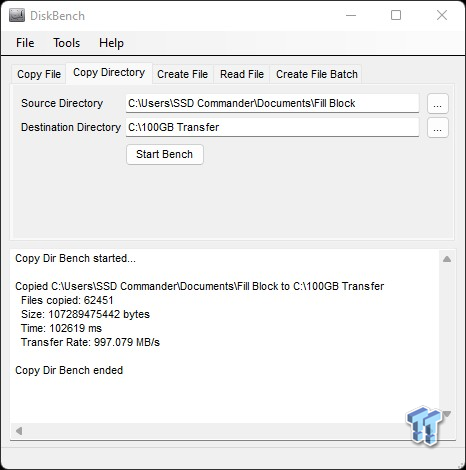
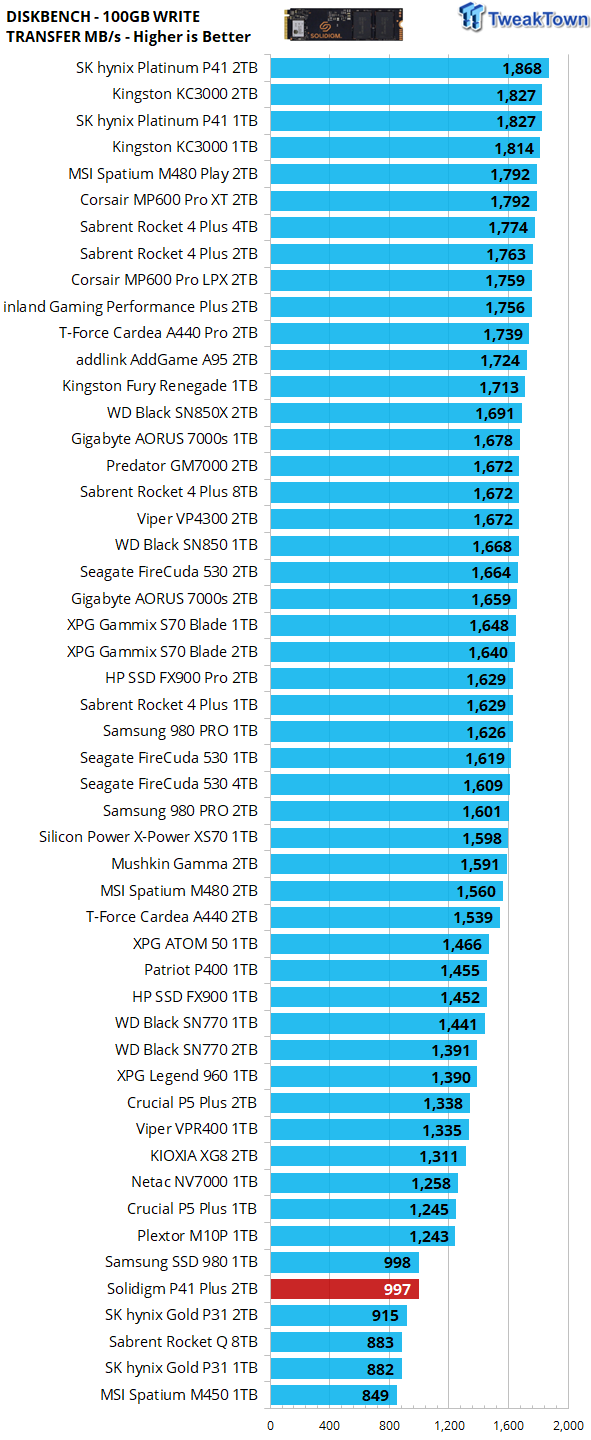
Our 100GB data transfer test is not your ordinary 100GB of data. Ours is a crushing mix composed of more than 62K files. Overall, write performance as it applies to the consumer realm is the least important performance metric, simply because the consumer realm is write infrequently, read frequently. For example, how many times is a game installed vs. how many times it's played? 997 MB/s is certainly not head-turning but actually quite good for a consumer QLC SSD.
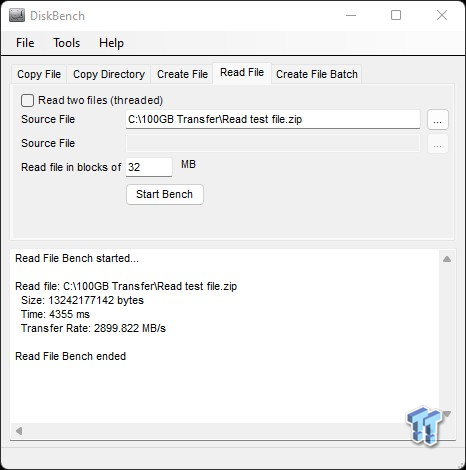
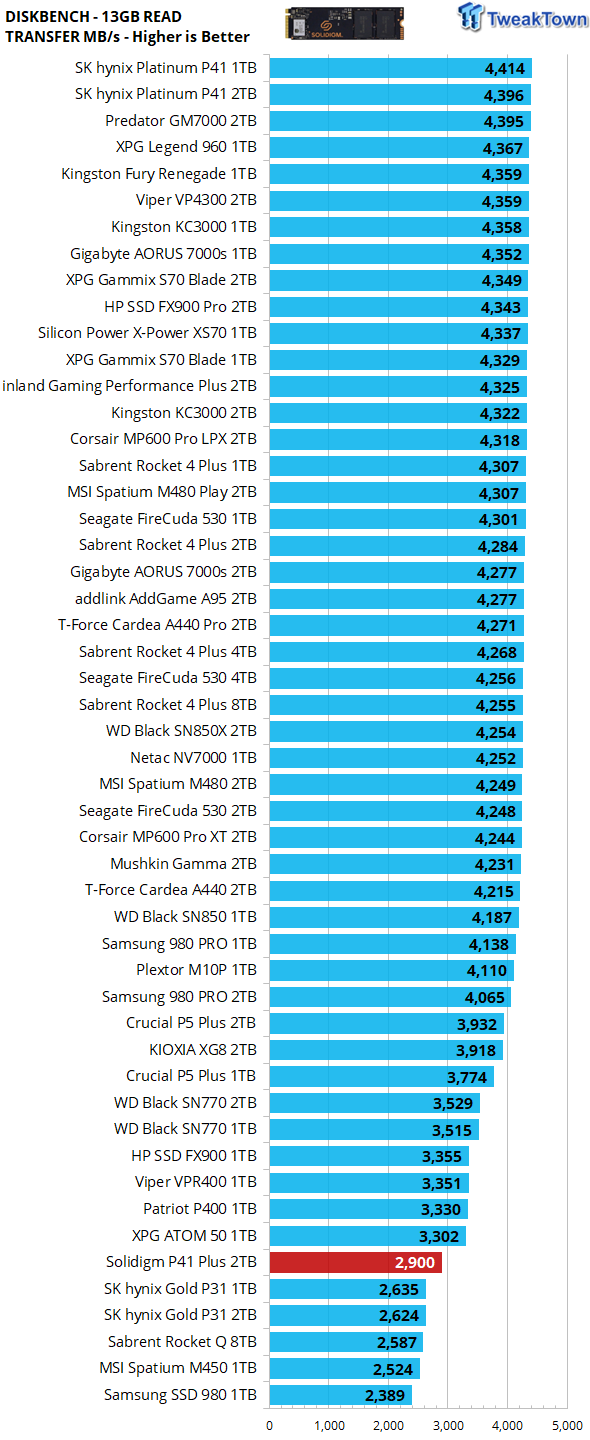
Results here are very much in-line with expectations for a DRAMess QLC SSD. It is about 15-20% lower than we see from its DRAMless competition, all stacked just above it, but those SSDs are all sporting 1600 MT TLC flash. Well, now that we've finished with our synthetic testing, let's see what the P41 Plus is REALLY made of with our real-world simulations or performance that MATTERS.
3DMark SSD Gaming Test
UL's newest 3DMark SSD Gaming Test is the most comprehensive SSD gaming test ever devised. We consider it superior to testing against games themselves because, as a trace, it is much more consistent than variations that will occur between runs on the actual game itself. This test is in fact the same as running the actual game, just without the inconsistencies inherent to application testing.
In short, we believe that this is the world's best way to test an SSDs gaming prowess and accurately compare it against competing SSDs. The 3DMark SSD Gaming Test measures and scores the following:
- Loading Battlefield V from launch to the main menu.
- Loading Call of Duty Black Ops 4 from launch to the main menu.
- Loading Overwatch from launch to the main menu.
- Recording a 1080p gameplay video at 60 FPS with OBS (Open Broadcaster Software) while playing Overwatch.
- Installing The Outer Worlds from the Epic Games Launcher.
- Saving game progress in The Outer Worlds.
- Copying the Steam folder for Counter-Strike Global Offensive from an external SSD to the system drive.
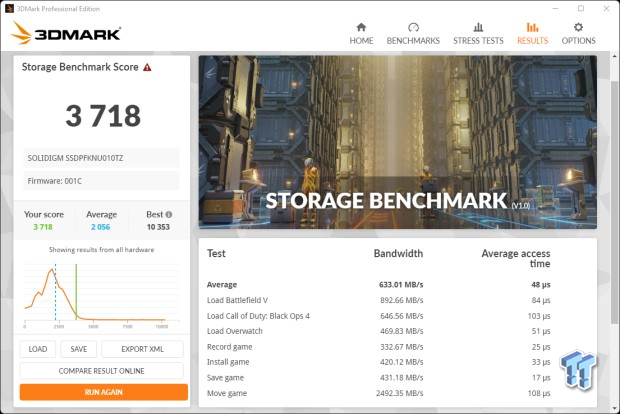
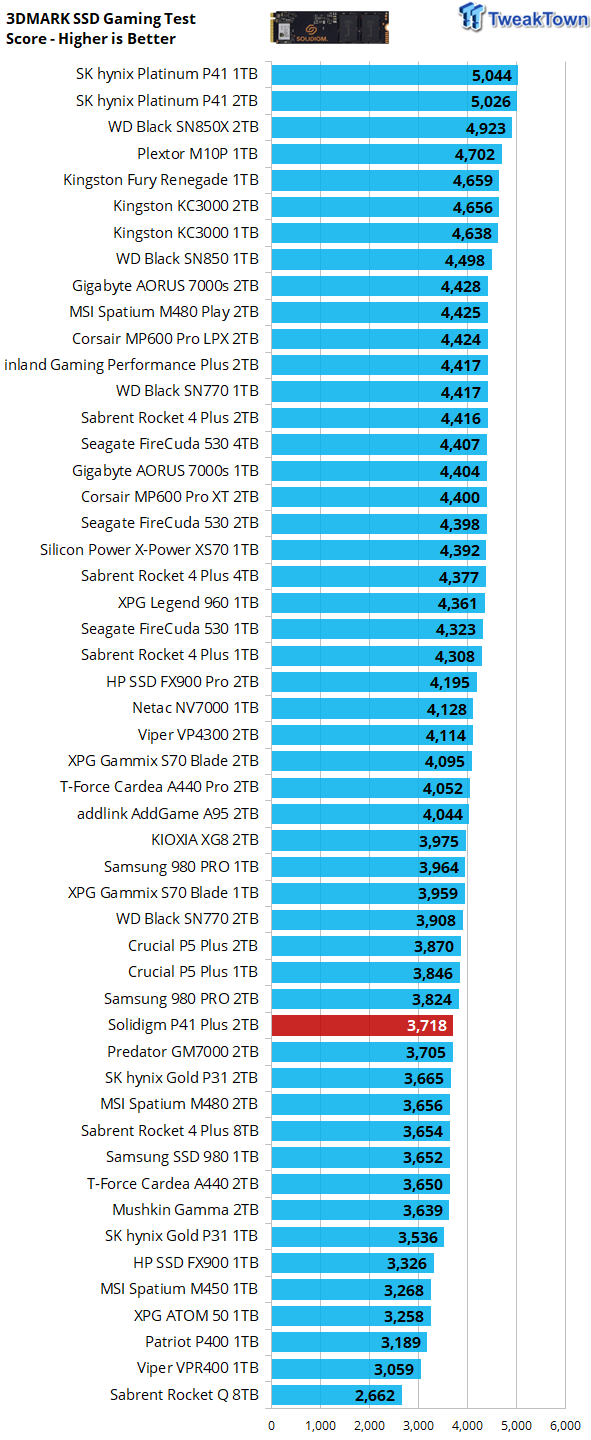
Gaming is a performance metric that matters to the majority of DIY consumers, especially to the enthusiast crowd that TweakTown caters to. Okay, here we go. This is performance that matters, and here we find the QLC arrayed P41 Plus laying the smack down on all of its DRAMless competition, except for the SN770. The ATOM 50, P400, and FX900 are all arrayed with 1600 MT Micron B47R 176 Layer TLC flash, yet what do we see here? Intel QLC out-performing B47R.
We see this as part of our proof, so to speak, that Intel QLC can perform better than much of the TLC flash currently in circulation. Additionally, this kind of performance reinforces our belief that Intel's QLC superiority is THE reason SK hynix bought Intel's flash business. Look at that chart - see how the P41 Plus can deliver gaming performance that is nearly as good as Samsung's 980 Pro?
Now, if you were to say that, well, maybe the P41 Plus having a different controller than the ATOM 50, P400, and the FX900 could be the reason why; that's a semi-legit point. However, the performance difference alone is more than we've ever seen a controller bring to the table; performance like that comes from the flash. Maybe it's capacity, then? Well, neither of those points pan out in reality because we have tested a 2TB SM2269XT SSD arrayed with B47R, and although not represented on this chart, the P41 Plus absolutely destroys it here and on the following charts as well.
PCM10 Storage Tests
PCMark 10 Storage Test is the most advanced and most accurate real-world consumer storage test ever made. There are four different tests you can choose from; we run two of them.
The Full System Drive Benchmark and the Quick System Drive Benchmark. The Full System Drive Benchmark writes 204 GB of data over the duration of the test. The Quick System Drive Benchmark writes 23 GB of data over the duration of the test. These tests directly correlate with mainstream user experience.
PCMark 10 Full System Drive Benchmark
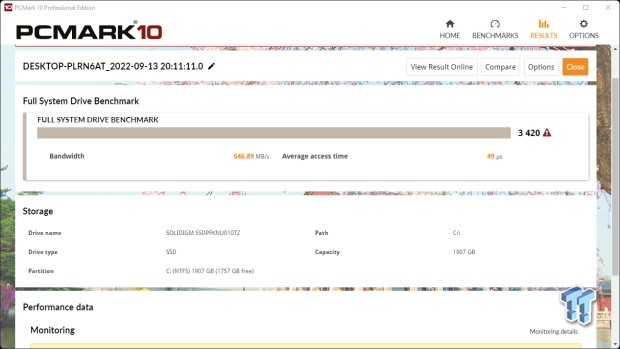
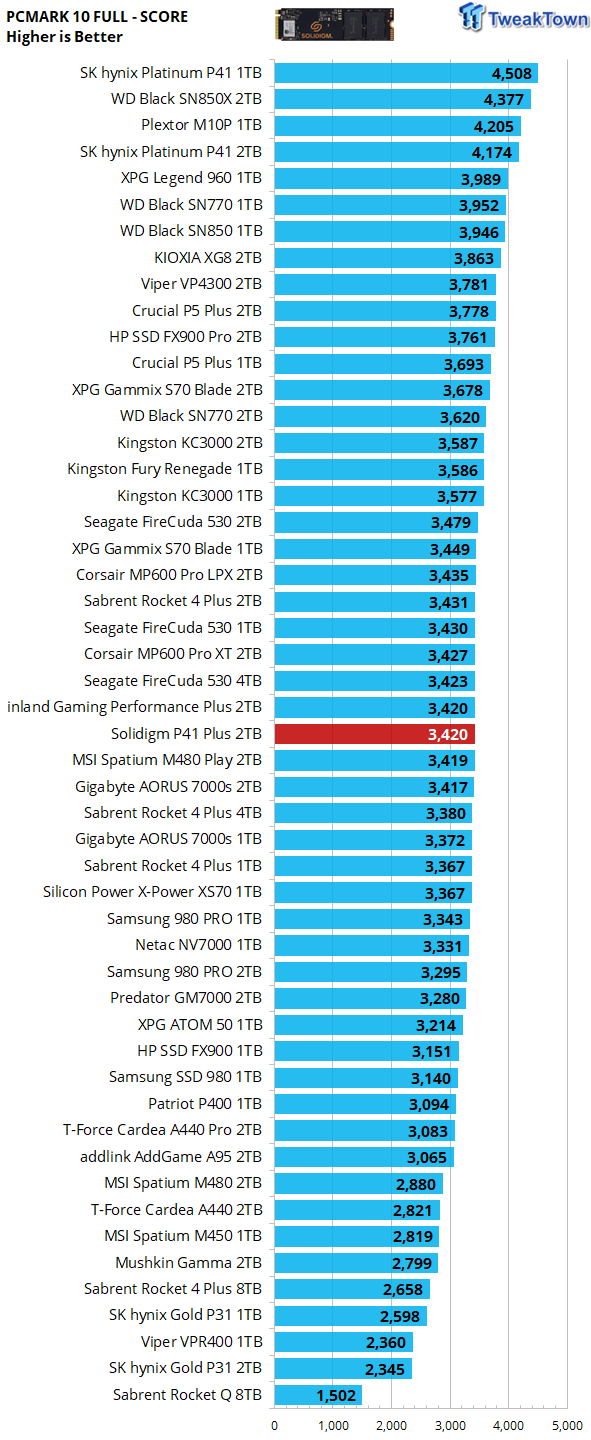
This particular test writes 204GB data and covers a broad range of common consumer tasks, including booting Windows 10, file transfers, Adobe and Office applications, and startup times for games, including Battlefield V, COD Black Ops 4, and Overwatch. Unlike synthetic numbers, this is comprehensive real-world data which is why we use it to rank SSDs in terms of user experience.
Incredible performance here where most DRAMless SSDs and QLC SSDs traditionally take a pummeling - heavy consumer workloads. Again, the P41 Plus handily outperforms its DRAMless competitors, again with the exception of the WD SN770. The WD SN770 is 10% more expensive than the P41 Plus, so there is a tradeoff for going that route. The SN770 is the better performer because, BiCS5 112 Layer TLC, unlike 176 Layer B47R, is better performing flash than Intel 144 Layer QLC.
The other tradeoff here would be power consumption because the P41 Plus has the lowest power draw of the Gen4 DRAMless SSDs, making it the superior choice for portable computing.
Finally, we would be remiss not to point to the fact that the P41 Plus is actually outperforming a whole host of fire-breathing 7,000 MB/s capable SSDs. This is performance that matters and, again, more proof positive that Intel QLC can outperform much of the TLC currently in circulation and do so where it actually matters to the end-user. Amazing.
PCMark 10 Quick System Drive Benchmark
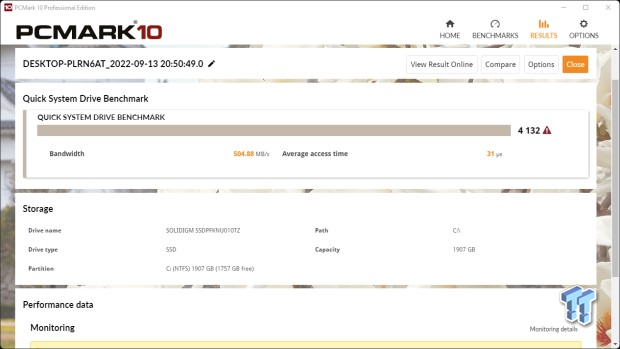
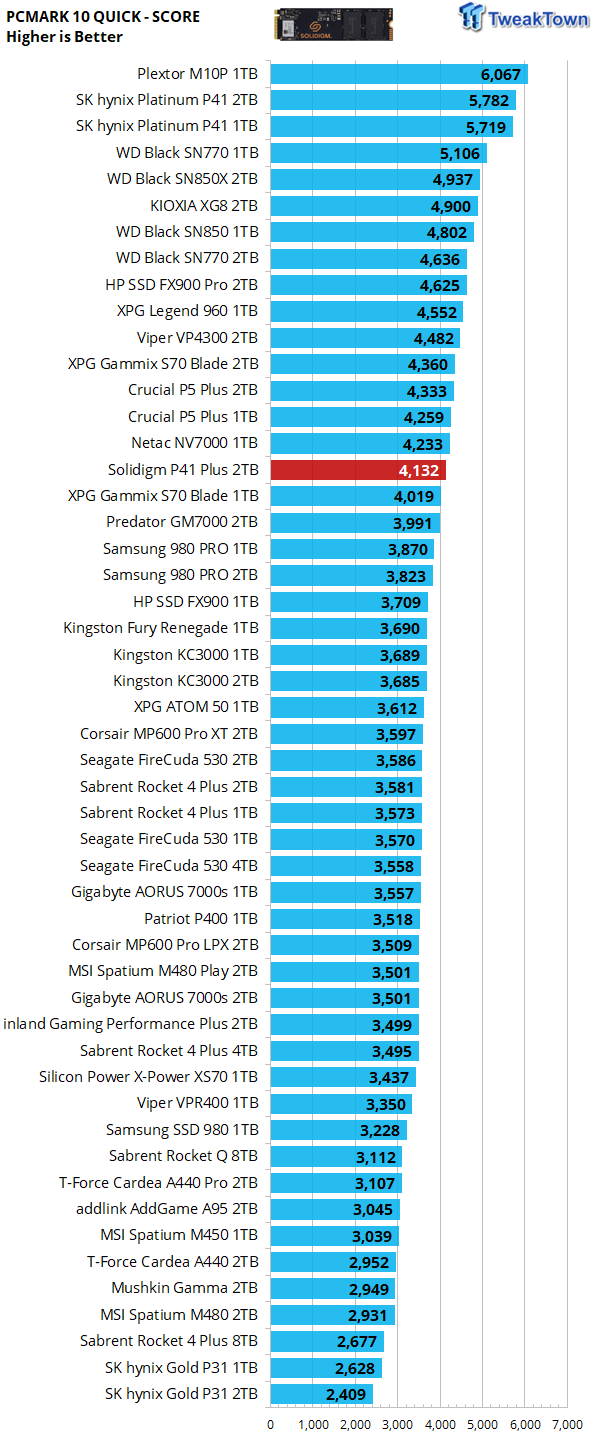
More of the same here, but this time the P41 Plus stacks even higher on our chart, which is overflowing with 7,000 MB/s capable SSDs, actually defeating most of them. Incredible - more solid proof that sequential throughput has nothing to do with real performance.
Additionally, this is the final proof we will point to backing up our assertion that Intel QLC is some of the best flash on the planet - in fact, better than much of the TLC flash currently in circulation.
Final Thoughts
It's been quite a hiatus for Intel and SMI as it relates to collaborative consumer offerings. We are glad to see they've both picked up where they left off, which is at the top of their respective SSD hardware disciplines.
For Solidigm, formerly Intel, the P41 Plus represents their first flash-based Gen4 SSD, and as we see it, they hit it out of the park. It makes sense that it would be a value-oriented DRAMless QLC SSD because Solidigm's parent company, SK hynix, is already the undisputed performance leader on the consumer Gen4 front, as proven by its Platinum P41.
With Solidigm in the fold, SK hynix now has the world's best-performing TLC flash and the world's best high-density QLC flash - quite the one-two punch.
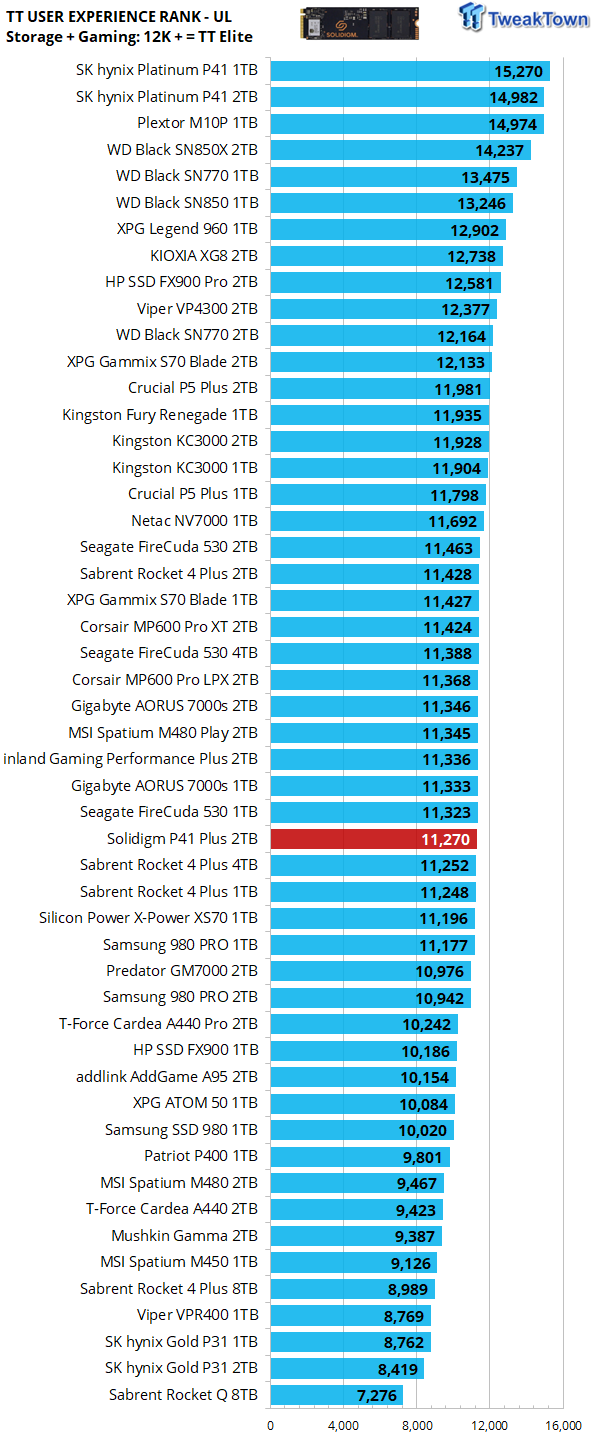
We rank SSDs in terms of overall user experience (performance where it matters most) as expressed by PCMark 10 storage and 3DMark gaming storage tests. We consider a user experience score of 12K or more to verify an SSD as a TweakTown Elite performer. While we certainly consider the P41 Plus to be Elite for what it is, it can't quite get there in terms of being a certified TweakTown Elite performer, but then again, most SSDs can't get there.
We will once again direct your attention to the above chart. Look at the enthusiast-level 7,000 MB/s capable SSDs, with this unassuming DRAMless QLC SSD beating like a drum. Not only is Intel QLC better performing than B47R TLC, but it's apparently better than Samsung's current crop of V-NAND as well. Look at the 980 Pro 1TB, currently Samsung's top performer; look at it being outperformed by the P41 Plus, where performance actually matters. Incredible.
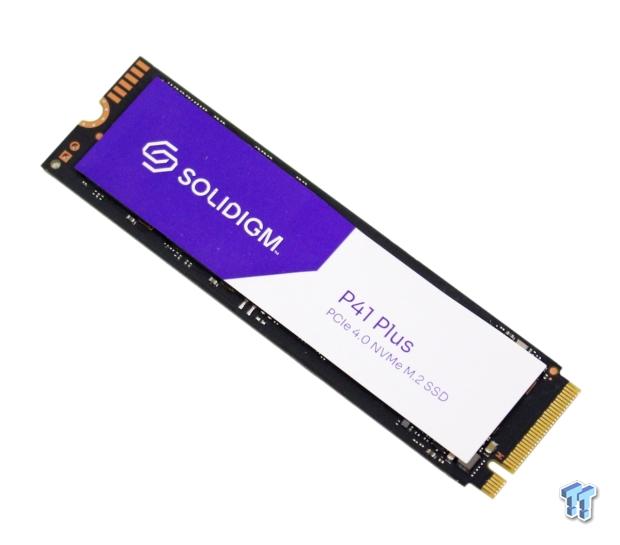
Solidigm is the first to employ Silicon Motion's SM2269XT power-sipping 4-channel DRAMless controller. We like what we see from this controller so much that it is our new favorite 4-channel DRAMless controller, supplanting the IG5220. Intel flash behind an SMI controller is hard to beat, and as such, the Solidigm P41 Plus has earned our highest award, which we can justify, based either on value or performance. Outstanding.

Performance | 99% |
Quality | 99% |
Features | 99% |
Value | 99% |
Overall | 99% |
The Bottom Line
Intel flash behind an SMI controller is something special indeed.



